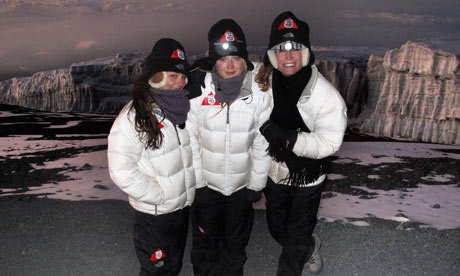
It's over. The red noses are packed away for another year. Cheryl Cole is back at Ashley's side. Chris Moyles is back in the pub. The world is as it should be. Unless, of course, you happen to be a Tanzanian travel agent. Because while the Red Nose climb of Kilimanjaro entertained us — Fearne Cotton with altitude sickness is a story we want to read — it's also put Africa's highest mountain on the map.
Last week, online ethical travel agency responsibletravel.com announced that enquiries about its Kilimanjaro package soared by 1,225%. Interest peaked, the company said, the day a TV documentary about the celebrity climb was broadcast. The nation has spoken. If Cheryl Cole can do it, then so can we. Where do we sign?
On the same day, however, I got an email bulletin from an organisation you probably won't have heard of, the International Mountaineering and Climbing Federation, inviting me to find out why those following the boot-prints of their favourite celebs should think again.
"Kilimanjaro," according to altitude medicine expert Dr Jeremy Windsor, "is perhaps one of the most dangerous mountains in the world. Despite reliable weather and straightforward access, illness and injury are commonplace. Of the 40,000 visitors Kili attracts each year, between 50 and 75% turn back before reaching the summit."
You could argue that it's the very fact Kilimanjaro is so easy to reach, and that climbing it is more like following the tourist track on Ben Nevis than Everest, that makes it so dangerous. Because while the ascent is more or less a walk that any fit adult can manage, and there's an international airport right next door, 5,895m is still pretty darned high.
Now, as any experienced trekker will tell you, the way to avoid altitude
sickness is to take your time. Travelling to almost 6,000m can't be rushed. As Dr David Hillebrandt, another altitude specialist, told me: "Would you choose to go on a holiday with an 80% chance of becoming sick with an illness that in some cases can, within hours, progress to becoming a life-threatening condition?"
And yet that's exactly what almost all of the people who try to climb Kili
choose to do. Partly it's through ignorance. Partly it's because that's how
travel agents have set things up. Mostly it's to do with the Tanzanian
authorities charging trekkers by the day to be on the mountain. That's a big incentive to get people up and down as fast as possible. The consequence is that most people who climb Kilimanjaro get sick unnecessarily, putting up with Acute Mountain Sickness because of tight schedules.
Kilimanjaro is now a multi-million-dollar business. That's good for the
Tanzanian economy, but climbing big mountains is a specialist business. It takes expertise. If you're inspired to try it yourself, follow Hillebrandt's advice and find an outfitter that spends at least five nights on the mountain before going to the summit. Or acclimatise on a cheaper peak nearby, like Mt Meru or Mt Kenya. The experience shouldn't be as grim as the Red Nose climbers found it. Kili is a beautiful place that should be seen without a splitting headache.
Most of all, spare a thought for the porters who will carry your bags. The
difficulty of their lives didn't feature at all in the feel-good coverage of
the Red Nose climb. But they are often underfed, underpaid and at times
exposed to mortal danger, quite unnecessarily. A small charity called Kilimanjaro Porters Assistance Project is aiming to make their lives better and raise awareness.
And since it's probable that like Cheryl, Fearne and Denise, Ronan, Gary and Chris, you'll be raising cash for charities back home, ask yourself about the propriety of flying to Tanzania to rush up a big mountain to raise money for a UK charity. If you decide to go ahead, at least make sure that the man who carries your bag is properly clothed and fed - and give him a good tip.

